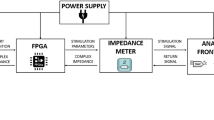Abstract
The high false-positive rate in clinical examinations limits the application of electrical impedance scanning (EIS) on breast cancer detection. One of the reasons is the non-uniform electrode–skin interface, which induces the ‘contact artifact’ in the results. To decrease the ‘contact artifact’, we designed a novel disposable electrode–skin interface [cotton fine grid thin layer (CFGTL)-interface], which is 0.2-mm thick and has a conductivity similar to that of normal breast tissue. The performance of the CFGTL-interface was evaluated by comparing it with the ultrasound gel interface generally used in EIS examinations. The test was conducted on 50 healthy female volunteers using two different interfaces separately, and a paired comparison method was used to analyze the effect of the CFGTL-interface on EIS measuring data. The results showed that the CFGTL-interface could effectively decrease the variation and the range of data fluctuation, which suggested that CFGTL-interface can decrease the ‘contact artifact’ and increase the accuracy of the examination. The CFGTL-interface appears to be an effective electrode–skin interface for breast EIS examination.



Similar content being viewed by others
References
Assenheimer M, Laver-Moskovitz O, Malonek D et al (2001) The T-SCANTM technology: electrical impedance as a diagnostic tool for breast cancer detection. Physiol Meas 22(1):1–8
Boone KG, Holder DS (1996) Effect of skin impedance on image quality and variability in electrical impedance tomography: a model study. Med Biol Eng Comput 34(5):351–354
Gabriel S, Lau RW, Gabriel C (1996) The dielectric properties of biological properties: measurements in the frequency range 10 Hz to 20 GHz. Phys Med Biol 41:2251–2269
Gilad O, Horesh L, Holder DS (2007) Design of electrodes and current limits for low-frequency electrical impedance tomography of the brain. Med Biol Eng Comput 45(7):621–633
Glichman YA, Filo O, Nachaliel U, Lenington S, Amin-Spector S, Ginor R (2002) Novel EIS postprocessing algorithm for breast cancer diagnosis. IEEE Trans Med Imaging 21:710–712
Guo Y, Sivaramakrishna R, Lu CC, Suri JS, Laxminarayan S (2006) Breast image registration techniques: a survey. Med Biol Eng Comput 44:15–26
Ji Z, Dong X, Shi X, You F, Fu F, Liu R (2007) Study of electrical impedance scanning system for breast screening. In: Proceedings of first international conference on bioinformatics and biomedical engineering, Wuhan, pp 1114–1116
Jossinet J (1996) Variability of impedivity in normal and pathological breast tissue. Med Biol Eng Comput 34:346–350
Jossinet J (1998) The impedivity of freshly excised human breast tissue. Physiol Meas 19:61–75
Jossinet J, Schmitt M (1999) A review of parameters for the bioelectrical characterization of breast tissue. Ann N Y Acad Sci 873:30–34
Malich A, Fritsch T, Anderson R, Boehm T, Fresmeyer MG, Fleck M, Kaiser WA (2000) Electrical impedance scanning for classifying suspicious breast lesions: first results. Eur Radiol 10:1555–1561
Malich A, Bohm T, Facius M, Freessmeyer M, Fleck M, Anderson R, Kaiser WA (2001) Additional value of electrical impedance scanning: experience of 240 histologically-proven breast lesions. Eur J Cancer 37:2324–2330
Malich A, Facius M, Anderson R, Bottcher J, Sauner D, Hansch A, Marx C, Petrovitch A, Pfleiderer S, Kaiser W (2003) Influence of size and depth on accuracy of electrical impedance scanning. Eur Radiol 13:2441–2446
Malich A, Bohm T, Facius M, Kleinteich I, Fleck M, Anderson R, Kaiser WA (2003) Electrical impedance scanning as a new imaging modality in breast cancer detection—a short review of clinical value on breast application, limitations and perspectives. Nucl Instrum Methods Phys Res A 497:75–81
McAdams ET, Jossinet J, Lackermeier A, Risacher F (1996) Factors affecting electrode–gel–skin interface impedance in electrical impedance tomography. Med Biol Eng Comput 34:397–408
Ng EY, Ng WK (2006) Parametric study of the biopotential equation for breast tumour identification using ANOVA and Taguchi method. Med Biol Eng Comput 44:131–139
Piperno G, Frei EH, Moshitzky M (1990) Breast cancer screening by impedance measurements. Front Med Biol Eng 2:111–117
Stuchly SS, Barr JB, Swarup A (1988) Dielectric properties of breast carcinoma and the surrounding tissues. IEEE Trans Biomed Eng 35:257–263
Scholz B, Anderson R (2000) On electrical impedance scanning principles and simulations. Electromedica 68:35–44
Acknowledgment
This work was supported partially by the National Natural Science Foundation of the People’s Republic of China under Grant 50337020.
Author information
Authors and Affiliations
Corresponding author
Rights and permissions
About this article
Cite this article
Ji, Z., Dong, X., Shi, X. et al. Novel electrode–skin interface for breast electrical impedance scanning. Med Biol Eng Comput 47, 1045–1052 (2009). https://doi.org/10.1007/s11517-009-0516-2
Received:
Accepted:
Published:
Issue Date:
DOI: https://doi.org/10.1007/s11517-009-0516-2




